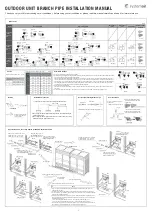
7 Configuration
Installer and user reference guide
27
RXYSCQ4~6TMV1B
VRV IV-S system air conditioner
4P404224-1C – 2019.07
c
Insulator
d
Transmission wiring (F1/F2)
e
Finishing tape
6.9.2
To close the outdoor unit
NOTICE
When closing the outdoor unit cover, make sure that the
tightening torque does NOT exceed 4.1 N•m.
5×
7
Configuration
7.1
Overview: Configuration
This chapter describes what you have to do and know to configure
the system after it is installed.
It contains information about:
▪ Making field settings
▪ Energy saving and optimum operation
INFORMATION
It is important that all information in this chapter is read
sequentially by the installer and that the system is
configured as applicable.
DANGER: RISK OF ELECTROCUTION
7.2
Making field settings
7.2.1
About making field settings
To configure the heat pump system, you must give input to the
outdoor unit's main PCB (A1P). This involves the following field
setting components:
▪ Push buttons to give input to the PCB
▪ A display to read feedback from the PCB
Field settings are defined by their mode, setting and value. Example:
[2‑8]=4.
PC configurator
For VRV IV-S heat pump system it is alternatively possible to make
several commissioning field settings through a personal computer
interface (for this, option EKPCCAB is required). The installer can
prepare the configuration (off-site) on PC and afterwards upload the
configuration to the system.
See also:
"7.2.9 To connect the PC configurator to the outdoor
.
Mode 1 and 2
Mode
Description
Mode 1
(monitoring
settings)
Mode 1 can be used to monitor the current
situation of the outdoor unit. Some field setting
contents can be monitored as well.
Mode 2
(field settings)
Mode 2 is used to change the field settings of
the system. Consulting the current field setting
value and changing the current field setting
value is possible.
In general, normal operation can be resumed
without special intervention after changing field
settings.
Some field settings are used for special
operation (e.g., 1 time operation, recovery/
vacuuming setting, manual adding refrigerant
setting, etc.). In such a case, it is required to
abort the special operation before normal
operation can restart. It will be indicated in
below explanations.
7.2.2
To access the field setting components
See
"6.2.2 To open the outdoor unit" on page 15
7.2.3
Field setting components
NOTICE
The DIP switch (DS1 on A1P) is not used. Do NOT change
the factory setting.
The components to make field settings are as follows:
A1P
X1M
X2M
BS2
SET
BS1
MODE
BS3
RETURN
BS4
TEST
BS5
RESET
H1P
H2P
H3P
H4P
H5P
H6P
H7P
MODE
TEST:
L.N.O.P. DEMAND
C/H SELECT
HWL:
IND
MASTER SLAVE
H8P
MULTI
BS1~BS5
Push buttons
H1P~H7P
7‑LEDs display
H8P
LED for indication during initialisation
ON (
) OFF ( ) Flashing (
)
Push buttons
Use the push buttons to make the field settings. Operate the push
buttons with an insulated stick (such as a closed ball-point pen) to
avoid touching of live parts.
BS1
MODE: For changing the set mode
BS2
SET: For field setting
BS3
RETURN: For field setting
BS4
TEST: For test operation
BS5
RESET: For resetting the address when the wiring is
changed or when an additional indoor unit is installed
7‑LEDs display
The display gives feedback about the field settings, which are
defined as [Mode-Setting]=Value.
H1P
Shows the mode
H2P~H7P
Shows the settings and values, represented in binary code
H8P
NOT used for field settings, but used during initialisation
Example:
H1P H2P H3P H4P H5P H6P H7P
-
+
+
+
+
+
[
H1P
32 16
8
4
2
1]
Description
(H1P OFF)
Default situation
(H1P flashing)
Mode 1
















































